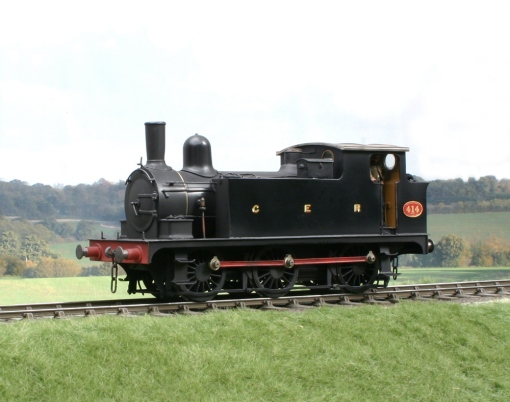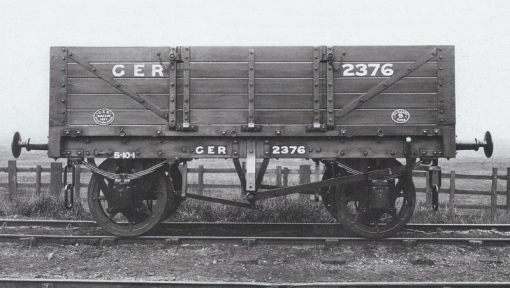In 1890 James Holden introduced a new development of his T18 class which had originally been designed for shunting and trip goods turns, but fortuitously turned out to be very good on the burgeoning suburban passenger services too.
When the need arose for further suburban tanks, Holden improved the design to suit intensive passenger work by providing a more steady-riding engine. This was achieved by increasing the trailing coupled wheelbase by six inches and reducing the length of the frames at the rear by one foot. In addition the tanks were repositioned further forward and the length of the cab shortened. Peripheral changes included moving the front steps from just ahead of the side tanks to in front of the sandboxes, and, as on the E22 class, positioning the spectacles higher on the weatherboards just under the eaves.
The ten locos were fitted for passenger work with Westinghouse brakes, screw reverse, screw couplings, destination board brackets on the smokebox door and bunker, and steel 10-spoke balanced wheels with a 10″ crank throw and straight brake pull rods.
As usual the new locos were classified by the initial batch order number and designated R24. They were numbered 327 to 336, numerically following on from the last of the T18 class. The R24s were released to traffic between 18th March and 18th April and sent to relieve the final batch of T18s working passenger duties on the Enfield and Chingford lines. The T18s were demoted to shunting duties and stripped of their Westinghouse brake equipment which was immediately fitted to the second batch of ten R24s (Order S24 numbered 337 to 346), already close to completion and originally intended for shunting duties. This second batch of passenger locos were handed over to the Running Department between 28th April and 14th May.
With the loss of the S24 order to the passenger side, it fell to the next two batches to make up the required number of shunting and trip goods locomotives; as intimated above, Holden had already decided not to revisit the T18 design, and the R24 class became his new standard for both passenger and shunting tanks. Twenty new locos were ordered in two consecutive batches to order numbers A26 and B26 and given running numbers 397 to 416. These were virtually identical to the R24 and S24 passenger locos with 7′ 9 ¾” wide tanks, cabs and bunker, but in common with the T18 class were fitted with handbrakes, lever reverse, and unbalanced 15-spoke cast iron wheels with an 11″ crank throw necessitating a reversion back to the 1½” drop sections in the brake rods underneath the path of the crankpin.
Following on from his steel firebox experiments with the E22 class, Holden fitted the ten locos to order A26 with copper inner fireboxes and those to order B26 with steel inner fireboxes from new, and the two batches provided a useful comparison. The twenty locos were released to traffic between 18th November 1890 and 24th January 1891 and nos. 407 to 416 retained their steel fireboxes until rebuilt between November 1901 and June 1907, when the fireboxes were scrapped and replaced by newly constructed copper ones.
Contrary to what has been published about these early steel fireboxes to date (and that includes both Yeadon’s Register, the RCTS ‘Green Bible’ and articles in the GER Society Journal), I can state with absolute certainty that these locos had their safety valves in the same position over the steel firebox as locos with copper fireboxes, and not over the rear ring of the boiler as previously believed. That particular modification came much later.
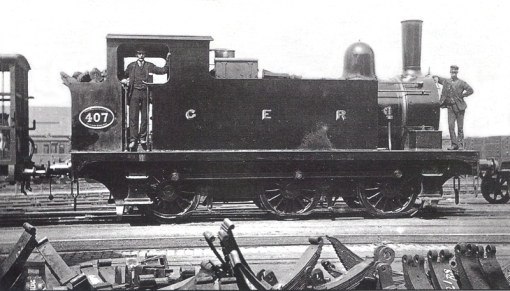
No.407 from Order B26 of 1890 was ex-Works on 26 November 1890 and released to traffic on 15 December. As seen here it represents Holden’s improved shunting loco, based on the T18 with the changes noted in the text above. Here at last is proof that the early experiments with steel inner fireboxes didn’t force the safety valves off the firebox onto the back ring of the boiler – the details on the number plate proves the loco hasn’t yet been rebuilt and the shrouded Ramsbottom valves are firmly seated in their original position. The Worsdell blower has the operating rod separate to the handrail, passing over the top of the tank, and the 15 spoke unbalanced wheels with an 11” crank throw require the same 1½” drop sections in the brake pull rods as the T18 class. Worsdell’s parallel buffer casings of 1882 are fitted. The toolbox has been moved to the drivers side, and looks pretty filthy, and there’s a conical re-railing jack up on the tank top – de rigueur for shunters as some of the permanent way in the GER sidings could be ‘interesting’. A nice mix of buffed paintwork and working grime. Photo © Public Domain.
A further twenty passenger tanks numbered 347 to 366 to orders P29 and R29 were released to traffic between 25th February and 18th May 1892. Whereas previous batches had had Worsdell’s pattern of spherical blower mounted on the smokebox above the separate boiler handrail with the operating rod passing along the top of the tank to a handwheel the cab, those in batch R29 (and possibly P29) had the blower mounted at the end of the handrail with the operating rod inside, passing through the tank to a handle in the cab.
From 1892 all new builds and replacement smokeboxes were of the flanged design with radiused edges, as described in the entry on the T18 class.
In 1893 all forty passenger tanks of the R24 design were fitted with condensing apparatus. Visually this consisted of a 6″ deep rectangular chamber fixed on top of each tank stretching from the cab to just behind the filler lid. A U-shaped pipe was bolted to the top of the left-hand chamber with a transverse pipe linking the two chambers across the top of the boiler, and venting pipes positioned behind on either side. An operating crank on the rear of the left-hand side of the smokebox was linked by a rod to the cab.
All of the passenger and shunting R24s up to this time were fitted with separate boiler and smokebox handrails and Roscoe displacement lubricators fixed to the side of their smokeboxes.
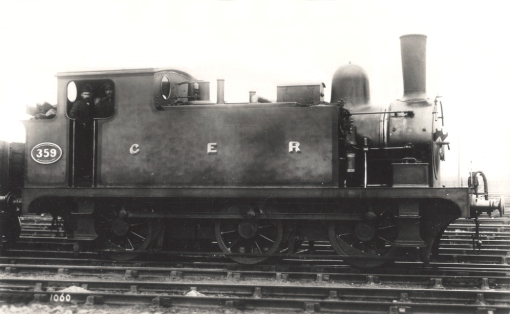
No.359 of Order R29 was ex-Works on 15 March 1892 and released to traffic on the 11 April. The similarities with the T18 design are obvious, but the relatively minor changes make it ‘just so’. The maximum date range for the photograph is 1893-1904 between the fitting of the condensing apparatus and its first rebuild. It has all the usual accoutrements of the early passenger R24s; early square-corner smokebox from built-up angle iron, the Worsdell blower attached to the end of the separate handrail, destination brackets on the smokebox door (and bunker), Holden’s tank filler lids with leather seals, the condensing chamber on the tank top along with the U-shaped tapered casting, copper connecting and vent pipes, and no coal rails on the bunker. The crew have moved the toolbox forward of the condensing pipes. Holden’s tapered buffer casings are fitted. The passenger rated tanks had 10-spoke balanced wheels with a 10” crank throw which led to straight brake pull rods, the Westinghouse pump in the tank front exhausting into the smokebox, brake hoses and screw couplings, and finally the passenger livery of ultramarine blue, lined vermilion and bordered black. Photo © Public Domain.
As a result of an exponential growth in suburban passenger traffic in the 1890s, between 1894 and 1896 the number of passenger rated R24s doubled; orders N33, F36, Y36 and C37, consisting of ten engines a-piece, were given running numbers 367 to 376, 377 to 386, 387 to 396 and 265 to 274, and these new batches exhibited visible modifications to the previous forty passenger locos, viz:
The condensing chambers were now built into the tank tops and the side sheets were extended upwards from the cab for about three quarters of the length of the tank to cover them, the design incorporated a sultry characteristic curve downwards at the front end by the filler lid. Batch C37 received boilers with steel inner fireboxes from new, and as with the earlier B26 order retained safety valves on the firebox, but were the last to do so – all future experiments with steel fireboxes would incorporate the safety valves on the back ring of the boiler. Numbers 265 to 374 retained these experimental fireboxes until they were rebuilt which took place between January 1908 and June 1912, long after the period covered by Basilica Fields.
The locomotives to order N33 of 1894 were the first of the type to receive continuous handrails from new, and over an extended period of time, some (but by no means all) of the previous sixty examples had their separate handrails replaced. The N33s were also the first to have Macallan blastpipes fitted from new, and all the earlier locos had them fitted as they came into Works. Sight-feed lubricators were another new modification and were fixed on the inner side sheet of the cab on the fireman’s side replacing the Roscoe displacement lubricators fitted to the smokebox. Again, earlier locos had them fitted as they passed through the Works.
The final modification made to the N33 batch was the fitting of Holden’s first design of blower valve, operated through a rod in the continuous handrail. The handrail was broken at the smokebox centreline and a crank attached to both the rod and a plunger which operated the side valve blower within the smokebox itself. Within a year Holden developed a new pattern of rotary blower which again was operated via a push-pull rod within the handrail attached. As before the rod was attached to a crank, but this time instead of a break in the handrail there was a slot in the back where the rod and crank joined. The rotary blower was first fitted to No.377 of Order F36 in 1895 and all subsequent engines.
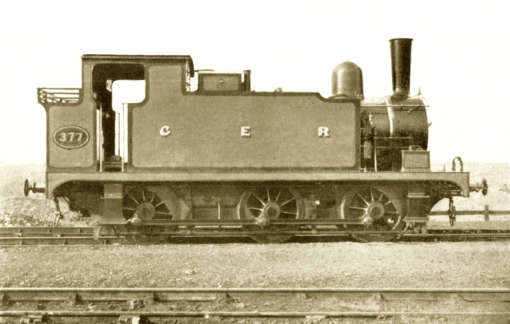
Not the best of photographs, No.377 the first loco from Order F36 was ex-Works on 10 October 1895. The photo was almost certainly taken just prior to its release to traffic on 11 November of that year. The loco represents the pinnacle of the passenger R24 design before rebuilding began. The new-style flanged smokebox, continuous handrails and rotary blower, condensing chambers built into the tank tops with side-sheets extending to the top (and that curve down to the filler lid), and three coal rails on the bunker. Holden’s tapered buffer casings are fitted. The toolbox on the driver’s side has been lined out (and on the original photo you can see it’s been numbered). Photo © Public Domain.
Some of the earlier locos which eventually received continuous handrails were also fitted with the rotary blower, others gained continuous handrails but retained the earlier Worsdell blower. Of course many locos kept both the separate handrails and Worsdell’s spherical blower and there were even a handful of examples which retained the separate handrails but were fitted with the intermediate design of side valve blower in place of the Worsdell blower mounted above the handrail. So much for standardisation!
Between 1895 and 1899 the twenty shunting tanks from batches A26 and B26 passed through the Works to be fitted with the steam brake. Coal rails were also fitted to the bunkers of most, but not all of the locos at this time.
Two more batches of shunting tanks were delivered between 1899 and 1900; numbers 255 to 264 and 199 to 208 formed orders H45 and G47 and were given boilers of a new design with two telescopic rings pressed to 160psi instead of the previous butt-jointed two ring boilers with a working pressure of 140psi. From here on, all new and replacement boilers would conform to this latest standard. These twenty shunters were fitted with the steam brake from new.

Photo: No.201 of Order G47 represents the final form of the R24 shunters in the GE period. Ex-Works on 8 December 1899 and released to traffic ten days later it’s seen here in mid-1921 having been rebuilt in 1915, but in almost the same condition as when first built with continuous handrails, flat-topped tanks (no condensing apparatus) and the MacAllan variable blastpipe crank and operating rod on the smokebox. Worsdell’s parallel buffer casings are fitted. The only ‘out-of-period’ differences being the heavy smokebox door (fitted 1915) and the bars over the rear spectacles (fitted from c1910). The livery is post-War grey with Train Control numbers on the tank sides. Who said pre-Group locos were all shiny? Photo © Public Domain.
The final twenty passenger-rated R24s, nos.199 to 208 and 160 to 169 to orders S48 and R50 were identical to the four batches introduced between 1894-6 and were released to traffic between 1900 and 1901, the last entering service on 6th September 1901.
A total of one hundred and forty locos to the R24 design had entered traffic in the space of eleven years. Although no more locos were built to this particular classification it was far from the end, and most of the passenger locos were on the cusp of a very significant change.
Services
The majority of the frenetic London suburban services hauled by the R24s out of Liverpool Street were allocated to the three principal branch lines of Chingford, Enfield and Palace Gates (which in 1920 would collectively form the famous ‘Jazz’ service) and routed north at Bethnal Green Junction via the 1872 route to Hackney Downs avoiding the Basilica Fields area which was situated about a mile east of the junction. In 1905 an astonishing twenty one trains an hour left Liverpool Street during the evening peak for these three branches alone, ten of which were diagrammed for the Chingford line. In contrast, during the period covered by this project there were always about a dozen or so trains in both directions each day to Chingford calling at Globe Road (Devonshire Street), Coborn Road and Basilica Fields on the Colchester line before turning north at Stratford, stopping at Lea Bridge before diverting onto the branch.
Many other suburban services on GER lines relied on the diminutive tanks and these included some interesting gems such as the three Woolwich services to Palace Gates, Chingford and Fenchurch Street – the latter running via either Stratford or exercising running rights over the Tilbury line via Bromley (-by-Bow). Other delights included Gospel Oak on the Tottenham & Hampstead Joint to both Chingford and Woolwich, and the East London Line services from Liverpool Street to the exotic destinations of New Cross and New Croydon on the Brighton Line via the Thames Tunnel and the East London Railway. Unfortunately none of these trains came within a mile or so of Basilica Fields, but there were a few services of interest which will be replicated including those from Liverpool Street to Woolwich, Gallions and the V&A Docks via Stratford Market. In addition the R24s occasionally took the slow outer suburban Hertford service via Stratford and Lea Bridge.
Although a number of locos were retained for passenger off-peak services (and night trains on the Chingford line for the artisan citizens of suburbia), many of the passenger-rated R24s were only required for the relentless morning and evening peak services. This meant that minor maintenance could be carried out during the day, freeing the locos up for night-time deployment on shunting turns and the vast number of trip goods workings serving the suburban goods yards between the hours of 10pm and 6am.
Modelling the R24s
The LNER J67 was one of Jim McGeown’s earliest Connoisseur Models kits, from c1991, and represent what later became of the GER shunting R24s. The kit has been unavailable as a stock item for many years and in modern terms it’s fairly basic, but is pretty good in all the essential dimensions, builds well and is an excellent foundation for a decent model. I have nine of the breed in the pile ready for assembly and conversion back to Great Eastern condition which involves scratchbuilding the cab interior and roof, and making several changes to the platework and castings.
As the passenger variety was also used on goods turns I’ve decided to build four shunting and five passenger examples, and in time will write separate journal entries on each.
Here’s one of the B26 batch of shunting engines I built to commission a couple of years ago.
References
- Great Eastern Locomotives Past & Present 1862-1945 – C Langley Aldrich RCTS Locomotives of the LNER Part 8A
- Locomotives Illustrated #116
- Yeadon’s Register Volume 48
- The Locomotive Magazine
- The Great Eastern Society Special #3 ‘All Stations to Liverpool Street’
- Lyn Brooks of the GERS
- John Gardner of the GERS
